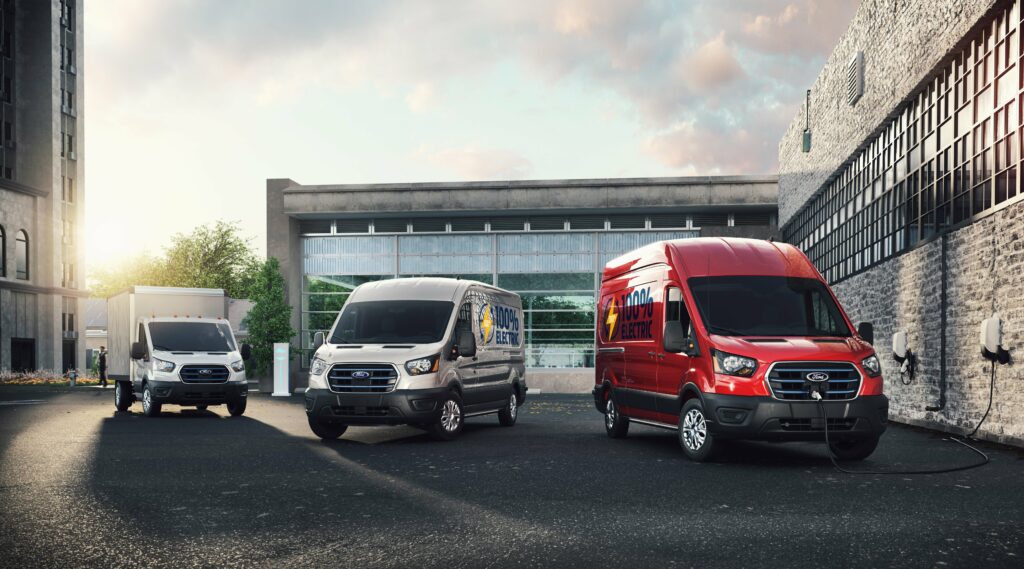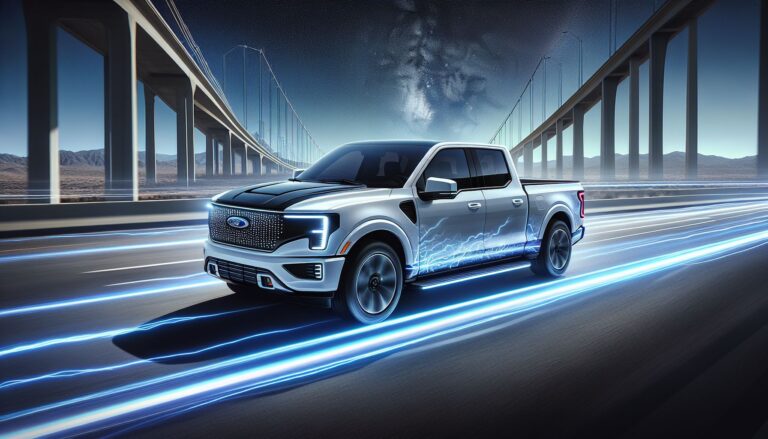Introducing the New 2026 Ford E-Transit: Revolutionizing Electric Commercial Transportation
Get ready to witness the future of electric commercial transportation with the New 2026 Ford E-Transit! This groundbreaking vehicle combines cutting-edge technology, exceptional performance, and sustainable innovation to redefine the way businesses operate. As we delve into its key features, specifications, and potential impact, prepare to be amazed by the transformative power of the E-Transit.
With its sleek exterior and spacious interior, the E-Transit not only meets the demands of modern businesses but also sets a new standard for electric vans. Its advanced powertrain and impressive range promise efficient and environmentally friendly operations, while its advanced safety features and driver-assistance systems ensure peace of mind on every journey.
Overview of the New 2026 Ford E-Transit
The New 2026 Ford E-Transit is a fully electric version of the popular Ford Transit van. It has a range of up to 200 miles on a single charge and can be charged using a standard 110-volt outlet or a 240-volt fast charger. The E-Transit is available in a variety of configurations, including cargo van, passenger van, and cutaway chassis. It is ideal for businesses that need a versatile and efficient vehicle for transporting goods or people.
The E-Transit is powered by a 266-horsepower electric motor that produces 317 pound-feet of torque. It has a top speed of 80 mph and can accelerate from 0 to 60 mph in 5.2 seconds. The E-Transit’s battery is located under the floor of the vehicle, which helps to lower its center of gravity and improve its handling.
The E-Transit comes standard with a variety of features, including a 12-inch touchscreen infotainment system, Apple CarPlay and Android Auto compatibility, and a suite of safety features. It is also available with a number of optional features, such as a sunroof, leather seats, and a navigation system.
Safety and Driver-Assistance Systems

The 2026 Ford E-Transit boasts a comprehensive suite of advanced safety features, ensuring peace of mind for drivers and passengers alike. These systems leverage cutting-edge technology to enhance visibility, prevent collisions, and mitigate the severity of accidents.
Driver-Assistance Technologies
The E-Transit is equipped with an array of driver-assistance technologies that actively assist drivers in maintaining control and avoiding hazards. These include:
- Adaptive Cruise Control: Maintains a safe following distance from vehicles ahead, automatically adjusting speed as needed.
- Lane-Keeping System: Detects lane markings and provides gentle steering corrections to keep the vehicle centered within its lane.
- Blind Spot Monitoring: Alerts drivers to vehicles in their blind spots, reducing the risk of lane changes or merging accidents.
Safety Ratings
The E-Transit has earned impressive safety ratings from leading organizations, including the National Highway Traffic Safety Administration (NHTSA) and the Insurance Institute for Highway Safety (IIHS). Its robust construction and advanced safety features have contributed to these top-tier ratings, surpassing many of its competitors in the electric van market.
Market Positioning and Competition

The New 2026 Ford E-Transit is poised to shake up the commercial van market, targeting a range of competitors. Key rivals include the electric versions of the Mercedes-Benz Sprinter, the Volkswagen Crafter, and the Renault Master.
Ford aims to capture a significant market share with the E-Transit, leveraging its strong brand recognition and reputation for reliability. Sales projections indicate a promising outlook, with analysts predicting strong demand for electric commercial vehicles as businesses seek to reduce emissions and embrace sustainable practices.
Pricing and Target Customer Base
The pricing strategy for the New 2026 Ford E-Transit is designed to make it accessible to a wide range of businesses. The vehicle will be offered in various configurations and battery options, allowing customers to tailor it to their specific needs and budget.
Ford’s target customer base for the E-Transit includes small businesses, delivery companies, and fleet operators. The vehicle’s versatility and customizable features make it suitable for a variety of applications, from urban deliveries to long-distance haulage.
Sustainability and Environmental Impact
The New 2026 Ford E-Transit is a significant step forward in the sustainability and environmental impact of commercial vehicles. As an all-electric van, it eliminates tailpipe emissions, reducing air pollution and contributing to cleaner air in cities and urban areas.
Environmental Benefits
The E-Transit’s zero-emission operation results in substantial reductions in greenhouse gas emissions compared to gasoline-powered vans. This not only benefits the environment but also aligns with the increasing demand for sustainable transportation solutions from businesses and consumers.
Sustainability Initiatives
Ford has incorporated sustainability initiatives into the design and manufacturing of the E-Transit. The vehicle’s body panels are made from recycled aluminum, reducing its carbon footprint and promoting a circular economy. Additionally, the E-Transit’s battery is designed for durability and longevity, minimizing the need for frequent replacements and contributing to a lower environmental impact over its lifespan.
Life-Cycle Assessment
A life-cycle assessment of the E-Transit reveals a significant reduction in carbon emissions compared to gasoline-powered vans. The assessment considers the vehicle’s production, operation, and end-of-life, providing a comprehensive understanding of its environmental impact.
Customer Reviews and Feedback
The New 2026 Ford E-Transit has received positive feedback from early adopters and industry experts alike. Many reviewers praise its impressive range, spacious interior, and advanced technology features.
Pros
* Excellent range: The E-Transit’s all-electric powertrain provides an impressive range of up to 200 miles on a single charge, making it ideal for long-distance deliveries and commutes.
* Spacious interior: The E-Transit offers a generous amount of cargo space, making it well-suited for hauling large loads.
* Advanced technology: The E-Transit comes equipped with a suite of advanced technology features, including a large touchscreen infotainment system, voice-activated controls, and driver-assistance systems.
Cons
* High price: The E-Transit is more expensive than its gasoline-powered counterparts, which may be a deterrent for some buyers.
* Limited availability: The E-Transit is still a relatively new vehicle, and its availability may be limited in some areas.
* Charging time: While the E-Transit’s range is impressive, it can take several hours to fully charge the battery, which may be inconvenient for some users.
Areas for Improvement
* Faster charging: Increasing the E-Transit’s charging speed would make it more convenient for users who need to charge their vehicles quickly.
* More affordable options: Offering more affordable trim levels would make the E-Transit more accessible to a wider range of buyers.
* Expanded availability: Increasing the availability of the E-Transit would make it easier for customers to purchase and use the vehicle.
Overall, the New 2026 Ford E-Transit is a promising electric van that offers a range of benefits. While it has some drawbacks, it is likely to become increasingly popular as electric vehicles become more mainstream.
Future Outlook and Innovations
The E-Transit is a crucial component of Ford’s electrification strategy, aiming to make electric vehicles more accessible and practical for commercial use. The automaker plans to invest heavily in electric van technology, with the E-Transit leading the charge.
Ford is actively exploring innovations and advancements in electric van technology to enhance the E-Transit’s capabilities and performance. These include improvements in battery efficiency, charging infrastructure, and autonomous driving features.
Battery Innovations
Ford is working on developing new battery technologies to increase the E-Transit’s range and reduce charging times. Solid-state batteries, which are more energy-dense and durable than traditional lithium-ion batteries, are a promising area of research.
Charging Infrastructure
Expanding and improving charging infrastructure is essential for the widespread adoption of electric vehicles. Ford is collaborating with partners to establish a network of fast-charging stations along major highways and in urban areas.
Autonomous Driving
Autonomous driving technology has the potential to revolutionize the transportation industry. Ford is exploring the integration of self-driving features into the E-Transit, which could improve safety, reduce driver fatigue, and increase efficiency.
The E-Transit and other electric vans are expected to play a significant role in reducing emissions and improving air quality in urban areas. They are also likely to drive down operating costs for businesses, as electricity is generally cheaper than diesel or gasoline.
The transportation industry is undergoing a major transformation, and electric vans like the E-Transit are at the forefront of this change. Ford’s commitment to innovation and electrification will shape the future of commercial transportation.
FAQ Summary
What is the target market for the New 2026 Ford E-Transit?
The E-Transit is designed for businesses of all sizes, particularly those with urban delivery, cargo transportation, and fleet management needs. Its versatility and customizable options make it suitable for a wide range of industries.
How does the E-Transit compare to its competitors in terms of performance?
The E-Transit boasts an impressive electric powertrain and battery capacity, providing competitive range and acceleration compared to other electric vans in the segment. Its advanced charging capabilities and efficient energy management system ensure minimal downtime and maximum productivity.
What are the key safety features available on the E-Transit?
The E-Transit prioritizes safety with a comprehensive suite of advanced features, including automatic emergency braking, lane departure warning, blind-spot monitoring, and adaptive cruise control. These systems work together to enhance driver awareness, reduce the risk of accidents, and provide peace of mind.
How does the E-Transit contribute to sustainability?
The E-Transit is an environmentally friendly choice, producing zero tailpipe emissions and significantly reducing greenhouse gas emissions compared to gasoline-powered vans. Its design incorporates sustainable materials and manufacturing processes, minimizing its overall environmental impact.
What are the future plans for the E-Transit?
Ford is committed to continuous innovation, and the E-Transit is no exception. Future plans include exploring autonomous driving capabilities, integrating advanced telematics systems, and developing even more efficient and sustainable powertrain technologies.


